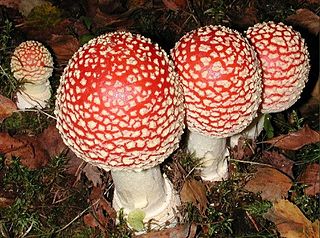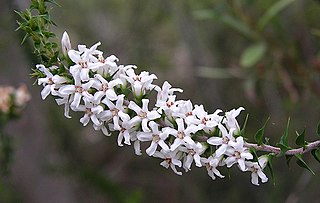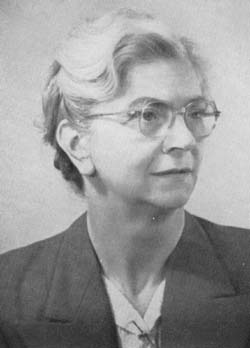Related Research Articles

A mycorrhiza is a symbiotic association between a fungus and a plant. The term mycorrhiza refers to the role of the fungus in the plant's rhizosphere, its root system. Mycorrhizae play important roles in plant nutrition, soil biology, and soil chemistry.

Calluna vulgaris, common heather, ling, or simply heather, is the sole species in the genus Calluna in the flowering plant family Ericaceae. It is a low-growing evergreen shrub growing to 20 to 50 centimetres tall, or rarely to 1 metre (40 in) and taller, and is found widely in Europe and Asia Minor on acidic soils in open sunny situations and in moderate shade.

The Russulaceae are a diverse family of fungi in the order Russulales, with roughly 1,900 known species and a worldwide distribution. They comprise the brittlegills and the milk-caps, well-known mushroom-forming fungi that include some edible species. These gilled mushrooms are characterised by the brittle flesh of their fruitbodies.

An Ideal Husband is a four-act play by Oscar Wilde that revolves around blackmail and political corruption, and touches on the themes of public and private honour. It was first produced at the Haymarket Theatre, London in 1895 and ran for 124 performances. It has been revived in many theatre productions and adapted for the cinema, radio and television.

An arbuscular mycorrhiza (AM) is a type of mycorrhiza in which the symbiont fungus penetrates the cortical cells of the roots of a vascular plant forming arbuscules. Arbuscular mycorrhiza is a type of endomycorrhiza along with ericoid mycorrhiza and orchid mycorrhiza.

The ericoid mycorrhiza is a mutualistic relationship formed between members of the plant family Ericaceae and several lineages of mycorrhizal fungi. This symbiosis represents an important adaptation to acidic and nutrient poor soils that species in the Ericaceae typically inhabit, including boreal forests, bogs, and heathlands. Molecular clock estimates suggest that the symbiosis originated approximately 140 million years ago.
Charles Henry Gimingham was a British botanist at the University of Aberdeen, patron of the Institute of Ecology and Environmental Management, former president of the British Ecological Society, and one of the leading researchers of heathlands and heathers.
Wanda Zabłocka was a Polish botanist, phytopathologist and mycologist. She was a professor at Nicolaus Copernicus University in Toruń (1954–1970). Zabłocka was the author of mycology and phytopathology works, including mycorrhiza of Viola. She is also the author of several books about fungi for the general public.

An ectomycorrhiza is a form of symbiotic relationship that occurs between a fungal symbiont, or mycobiont, and the roots of various plant species. The mycobiont is often from the phyla Basidiomycota and Ascomycota, and more rarely from the Zygomycota. Ectomycorrhizas form on the roots of around 2% of plant species, usually woody plants, including species from the birch, dipterocarp, myrtle, beech, willow, pine and rose families. Research on ectomycorrhizas is increasingly important in areas such as ecosystem management and restoration, forestry and agriculture.
John Laker Harley CBE FRS FLS FIBiol was a British botanist, known for his work on ectomycorrhizal physiology.
James Martin Trappe is a mycologist and expert in the field of North American truffle species. He has authored or co-authored 450 scientific papers and written three books on the subject. MycoBank lists him as either author or co-author of 401 individual species, and over the course of his career he has helped guide research on mycorrhizal fungi, and reshaped truffle taxonomy: establishing a new order, two new families, and 40 individual genera.
John William Gibson Cairney (1959–2012) was an eminent Scottish–Australian mycologist and Director of the UWS Centre for Plants and the Environment. Cairney specialised in mycorrhizal biology and ecology, particularly of ericoid- and Ectomycorrhiza. Cairney contributed significantly to mycorrhizal research, publishing over 150 manuscripts and serving as the associate editor, editor or on the advisoral panel for numerous scientific journals including: New Phytologist, Plant and Soil, Mycological Research and the Journal of Soils and Sediments.
Sarah Elizabeth Smith was a British-born Australian mycologist specialising in mycorrhiza. The Australian Academy of Science described her as "a world authority on the mycorrhizal symbiosis between plants and fungi". She was an adjunct and emeritus professor at the University of Adelaide, in the School of Agriculture, Food and Wine.
Yolande Dalpé is a former Research Scientist with Agriculture and Agri-Food Canada. She became the first mycologist in Ottawa to study the taxonomy of mycorrhizal fungi. Her research focuses on developing new information on taxonomy, phylogeny, distribution and biology of fungi, including systematic research related to biosecurity/alien invasive species as well as species involved in the development of bioproducts. She was awarded the Lawson Medal by the Canadian Botanical Association for her "cumulative, lifetime contributions to Canadian botany, for the research she has performed in mycology, and has been recognized nationally and internationally." The standard author abbreviation Dalpé is used to indicate this person as the author when citing a botanical name.

Mariya Yakovlevna Zerova, alternately Marija Jakovlevna Zerova, was a Ukrainian biologist and taxonomist known for her work in mycology.
Orchid mycorrhizae are endomycorrhizal fungi which develop symbiotic relationships with the roots and seeds of plants of the family Orchidaceae. Nearly all orchids are myco-heterotrophic at some point in their life cycle. Orchid mycorrhizae are critically important during orchid germination, as an orchid seed has virtually no energy reserve and obtains its carbon from the fungal symbiont.
Mycorrhizal amelioration of heavy metals or pollutants is a process by which mycorrhizal fungi in a mutualistic relationship with plants can sequester toxic compounds from the environment, as a form of bioremediation.
Lynne Boddy is a Professor of Microbial Ecology at Cardiff University. She works on the ecology of wood decomposition, including synecology and autecology. She won the 2018 Learned Society of Wales Frances Hoggan Medal.
Nancy Collins Johnson is an American earth scientist who is the Regents’ Professor and Director of the School of Earth Sciences & Environmental Sustainability at Northern Arizona University. Her work considers soil microbial ecology and the study of mycorrhizal fungi. She was elected a Fellow of the American Association for the Advancement of Science in 2020.

Lilian Edith Hawker was a British mycologist, known for her work on fungal physiology, particularly spore production. She was an expert on British truffles, and also published in the fields of plant physiology and plant pathology. She was also known for her contributions to education in mycology. Most of her career was spent at the botany department of the Imperial College of Science and Technology (1932–45) and the University of Bristol (1945–73), where she held the chair in mycology (1965–73) and was dean of the science faculty (1970–73). She served as president of the British Mycological Society, and was elected an honorary member of that society and of the Mycological Society of America. She published an introduction to fungi and two books on fungal physiology, of which Physiology of Fungi (1950) was among the first to survey the field, and also co-edited two microbiology textbooks.
References
- 1 2 3 "Dr. Mabel Rayner, Botanist, Dies". The Vancouver Sun. 1948-12-22. Retrieved 2021-04-13.
- 1 2 3 Ogilvie, Marilyn; Harvey, Joy (2003-12-16). The Biographical Dictionary of Women in Science: Pioneering Lives From Ancient Times to the Mid-20th Century. Routledge. ISBN 978-1-135-96343-9.
- ↑ "University of London Archives | Details". archives.libraries.london.ac.uk. Retrieved 2021-04-13.
- 1 2 3 4 Haines, Catharine M. C.; Stevens, Helen M. (2001). International Women in Science: A Biographical Dictionary to 1950. ABC-CLIO. ISBN 978-1-57607-090-1.
- ↑ RAYNER, M. CHEVELEY (1915-01-01). "Obligate Symbiosis in Calluna Vulgaris". Annals of Botany. os-29 (1): 97–98. doi:10.1093/oxfordjournals.aob.a089540. ISSN 0305-7364.
- 1 2 Rayner, M. C; Jones, W. Neilson; Recorded Books, Inc (2018). A textbook of plant biology. S.l.: White Press. ISBN 978-1-5287-8496-2. OCLC 1155507314. Archived from the original on 2021-05-18. Retrieved 2021-04-13.
{{cite book}}:|first3=has generic name (help) - ↑ Ainsworth, Geoffrey C. (1996). Brief Biographies of British Mycologists (PDF). Stourbridge, West Midlands: British Mycological Society. p. 138.
- ↑ Martin I, Bidartondo (August 2005). "The evolutionary ecology of myco‐heterotrophy". New Phytologist. 167 (2): 335–352. doi: 10.1111/j.1469-8137.2005.01429.x . PMID 15998389.
- ↑ Fanstone, Ben Paul (27 October 2016). "The pursuit of the 'good forest' in Kenya, c.1890-1963: the history of the contested development of state forestry within a colonial settler state" (PDF).
- ↑ Desmond, Ray (2020-12-23). Dictionary Of British And Irish Botantists And Horticulturalists Including plant collectors, flower painters and garden designers. CRC Press. ISBN 978-1-000-16286-8.